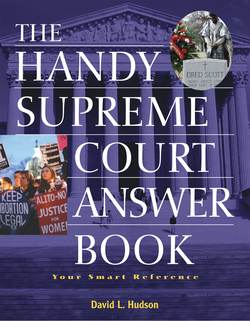Читать книгу The Handy Supreme Court Answer Book - David L Hudson - Страница 8
Introduction
ОглавлениеAbortion, affirmative action, capital punishment, medicinal usage of marijuana, religious freedom, treatment of captives during the War on Terror, and even a presidential election. All these pressing societal issues have been examined by a body of nine (since 1869) jurists in the so-called “Court of Last Resort.” The U.S. Supreme Court has the final say in our judicial system. Our fourth (and perhaps greatest) chief justice—John Marshall—declared the power of judicial review for the U.S. Supreme Court and lower courts in Marbury v. Madison (1803) when he wrote that “it is emphatically the province and duty of the judicial department to say what the law is.”
Like all other public institutions, sometimes the Court has performed miserably, as it did in Dred Scott v. Sandford (1857) when sanctioning slavery. At other times, the Court has led the way to a more just society, as it did when ruling unanimously that segregated public schools violated the Equal Protection Clause in Brown v. Board of Education (1954).
Yet, the Court remains a mystery to many citizens. Its hearings are not televised and some justices remain committed to keeping cameras out of the courtroom forever. When asked about the possibility of such coverage, Justice David Souter reportedly said, “Over my dead body!” Most people cannot name all the justices of the Supreme Court. Some may know Clarence Thomas from his contentious (and, at times, salacious) confirmation hearing in 1991; others knew Sandra Day O’Connor because of her gender-breaking role. However, the average person may not know the names of John Paul Stevens, Antonin Scalia, Anthony Kennedy, and the rest of the current justices.
The Handy Supreme Court Answer Book seeks to increase reader knowledge on this important public institution. It provides a comprehensive overview of the Court from its inception in 1789 to the present. There have been seventeen chief justices in the history of the Court—from John Jay to John G. Roberts Jr. This book examines all seventeen justices and their Courts, as well as many of the nearly one hundred associate justices who have served in this venerable institution.
Most of the book is divided into chapters based on the name of the particular chief justice. Some periods were much longer and more significant than others. For instance, Chief Justice Marshall served more than thirty years in his role as head of the Court. On the other hand, Chief Justice Harlan Fiske Stone served only five. Earl Warren presided over a Court from 1953 to 1969 that literally transformed American society. More recently, William H. Rehnquist presided over the Court from 1986 to 2005, ushering in a new era of federalism that recalibrated the balance between federal and state governments.
For each period, the book opens with interesting questions and answers regarding the justices on that particular Court. It then presents information regarding the Court’s major decisions during that time period. Readers will learn about the landmark cases of Marbury v. Madison (1803), Gibbons v. Ogden (1824), Dred Scott v. Sandford (1857), the Civil Rights Cases (1883), Powell v. Alabama (1932), Brown v. Board of Education (1954), Gitlow v. New York (1925), Miranda v. Arizona (1966), Roe v. Wade (1973), and Bush v. Gore (2000). Readers also will read about many of the protagonists in these famous cases—the litigants, attorneys, and jurists who helped shape American law. For instance, The Handy Supreme Court Answer Book examines the landmark decision of Gideon v. Wainwright (1963), in which the Court ruled that the Sixth Amendment right of assistance of counsel (right to a lawyer) was extended to the states. Readers will learn about the plaintiff and former petty thief Clarence Earl Gideon, his lawyer (and future U.S. Supreme Court justice) Abe Fortas, and the justice who rendered the Court’s opinion, Hugo Black—who stayed on the Court long enough to see his dissenting opinion from twenty-one years earlier in Betts v. Brady (1942) become the law of the land. Also covered are the Supreme Court cases involving such cultural celebrities as Larry Flynt, Jerry Falwell, and Anna Nicole Smith. Readers also discover how famous Court language such as “shouting fire in a theatre” contributed mightily to jurisprudence on the First Amendment—the first 45 words in our Bill of Rights.
For the most important opinions, the book provides key excerpts from the Court’s opinions—not only the majority opinions but also from concurring and dissenting opinions. Sometimes justices on the Court—just like all of us in society—disagree on fundamental questions of law and policy. Some of these divisions are brought to life in the following pages.
Additionally, the book provides opening chapters on the origins of the Court, the structure of the American judicial system, and interesting trivia about the individuals (108 men and 2 women) who have donned the black robes in the so-called “Marble Palace.” The author sincerely hopes that you find the book as informative while reading it, as he did in preparing it. Thank you for your interest in the Court!
David L. Hudson Jr.
